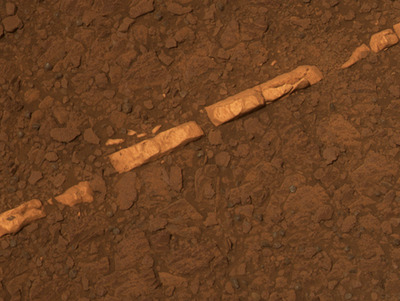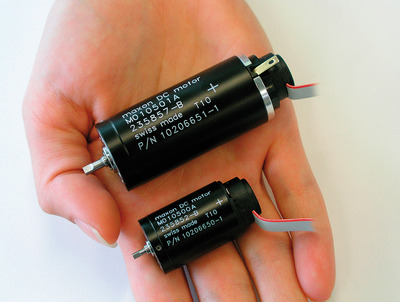Mars rover finds signs of water
Monday, 02 January, 2012
A rover has found evidence suggesting that water once flowed on the Red Planet.
In the eighth year of its expedition, the rover 'Opportunity' has found evidence that water once existed on Mars. According to briefings by NASA in late 2011, the rover found a vein of a notably light-coloured mineral, apparently gypsum, deposited by flowing water. Scientists are excited by the discovery and are convinced that it proves that water once flowed at this site.
On its way through the desolate Meridiani plane, the rover came across the light-coloured streaks in the ground by chance. An analysis of the minerals should help scientists better understand the geological history of Mars.
Billions of years ago the atmosphere on Mars was significantly denser and evidence indicates that there was once water in abundance on the surface of the planet. Today, the atmosphere is too thin to allow water to exist in liquid form.
The deposits formed at the same point on Mars where they are located today. At this very point, water escaped from cracks in the bedrock. Calcium that had dissolved from the volcanic rock was washed away. In the process, the calcium reacted with sulfur that had either leached from the rock or was introduced by volcanic gases. One of the analysed gypsum deposits on the edge of Endeavour Crater is approximately 50 cm long and 2 cm wide.

Prior to this discovery, Opportunity had not found anything similar to the gypsum deposit, which scientists refer to as the 'Homestake.' According to Steve Squyres, principal investigator for Opportunity and professor at Cornell University in Ithaca, this mineral is common on Earth, but on Mars, this discovery is almost a miracle; the type of event that makes geologists jump out of their chairs.
"This tells a slam-dunk story that water flowed through underground fractures in the rock," said Squyres.
In January 2012, Opportunity will celebrate its eighth birthday on the Red Planet. Originally, the mission was planned to last just 90 days. Since January 25 2004, the rover has been exploring Mars on behalf of NASA.
Opportunity has covered about 35 km and, in the process, transmitted almost 162,400 images of the surface and the atmosphere of the Red Planet to the mission control centre in Pasadena, California.
Motors manufactured by maxon motor ensure that the Mars rover is able to safely navigate the surface of Mars. A total of 39 DC motors are at work in Opportunity. The precision drives are used to drive the robotic arm, the Rock Abrasion Tool (RAT), the camera operation and the control mechanism for the six wheels that propel the 180 kg vehicle, 1.6 m long and 1.5 m high, across the surface of Mars.

The motors are largely standard products with diameters of 20 to 25 mm and an efficiency of over 90%. Minor modifications were necessary to adapt the motors for the harsh environmental conditions: the temperature on Mars can fluctuate from -120 to 25˚C, and the atmosphere largely consists of carbon dioxide.
Originally, two rovers were active on Mars; however, since March 2010, NASA has been out of contact with Opportunity's twin, 'Spirit.' A next-generation rover is already on the way to resume where Spirit left off: 'Curiosity,' a space lab launched by NASA in November, is scheduled to land on Mars in August 2012.
Solar-powered reactor uses CO2 to make sustainable fuel
Researchers have developed a reactor that pulls carbon dioxide directly from the air and converts...
Scientists simulate the effects of an asteroid collision
How would our planet physically react to a future asteroid strike? Researchers simulated an...
2024 was warmest year on record, 1.55°C above pre-industrial level
The World Meteorological Organization says that 2024 was the warmest year on record, according to...




